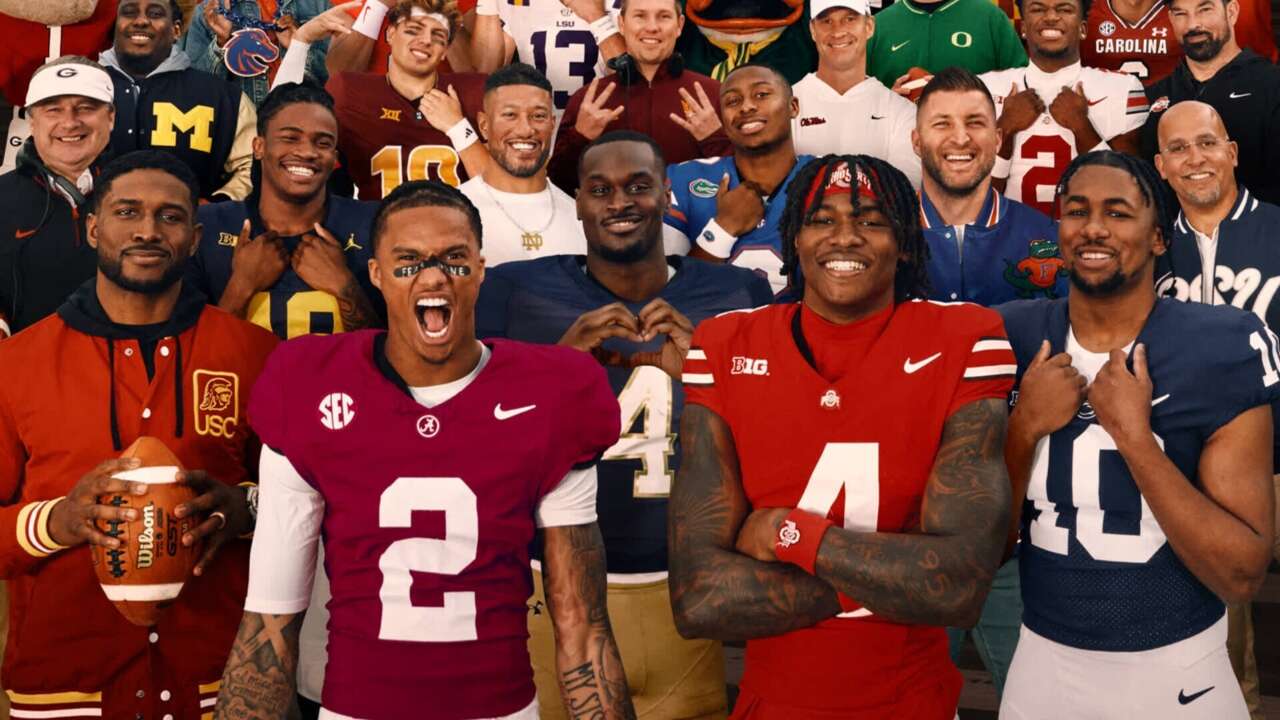The people yearn for college football. After an 11-year hiatus, EA’s collegiate football series returned last year and quickly set US records as the best-selling sports game of all time. That’s no mean feat, but EA Orlando isn’t resting on its laurels with EA Sports College Football 26. The latest game in the series has its flaws, but ultimately improves upon its predecessor in a multitude of ways, with modes like Dynasty, Road to Glory, and the game’s renewed emphasis on rivalries honing in on what makes the college football experience unique when compared to Madden and other professional sports games.
All of this starts with the presentation. Whether it’s 100,000 fans belting out Mr. Brightside inside The Big House or Virginia Tech’s players emerging from the tunnel to the pounding drums and iconic riffs of Enter Sandman, there’s an impressive attention to detail that ensures almost all of the 136 schools in the game feel both authentic and singular to their specific college traditions, pageantry, and stadium atmosphere. There are significantly more pre-game runouts than before, with many of the smaller teams now stepping onto the field with their own individual rituals included. Some of the larger teams’ runouts have also been updated since last year, adding to the game’s pomp and circumstance by featuring traditions like Oklahoma’s Sooner Schooner and South Carolina’s Cockaboose.
There are dozens of new mascots, too, as well as new pre-game marching band formations to go along with an incredible soundscape of snare drums, trombones, and French horns that enhances each stadium’s kinetic atmosphere. A few teams also have specific touchdown and turnover celebrations, rewarding each takeaway with a short cutscene, such as Arizona piercing footballs with their turnover sword or a Georgia player donning their savage pads.
Even night games feel momentous, thanks to the addition of authentic light and drone shows that amplify the spectacle of these big matchups. For instance, the whole Bryant-Denny Stadium lights up in red before Alabama Crimson Tide games, while a fleet of drones projects Texas’s famous Longhorn logo onto the night sky. These moments often set the stage for intense rivalry games where school pride and championship aspirations are put on the line.
Much like the pageantry and traditions of each school, rivalries are a staple of college football, to the point where EA Orlando has ensured these heated matchups are just as important in College Football 26. There are over 80 rivalries included, with specific stats, graphics, and commentary lines added to the game’s broadcast package whenever you’re involved in one. From the historic Minnesota vs. Wisconsin rivalry dating back to 1890, to the Holy War between Utah and BYU, the epic Red River Rivalry of Texas and Oklahoma, and the Army-Navy matchup that sees two branches of the military go to war on the gridiron, almost every rivalry you can think of is featured.

Many of these games also put trophies on the line, such as the Paul Bunyan Trophy awarded to the winner of the Michigan vs. Michigan State game, or the Victory Bell from the Battle of Los Angeles. College Football 26 features a trophy room that keeps track of every rivalry trophy you’ve won across each mode, along with others like the Heisman and National Championship. Aside from providing an incentive to engage with every rivalry game, you’re also rewarded with a brief description of the trophy’s history and significance within the tapestry of college football.
Of course, this wouldn’t mean much if the on-field action wasn’t up to snuff, but College Football 26 manages to avoid the sophomore slump with a vastly expanded playbook, unique AI for quarterbacks, better animations, and improved pass coverage, among other improvements–it’s about as good as video game football gets. The pace is slightly slower than last year, and ball carrier moves don’t feel quite as explosive, but the added responsiveness to player movement makes it easier to find gaps in the offensive line and avoid pursuing defenders.
Quarterbacks also play similarly to how they do in real life, with each one falling under a specific archetype, such as Backfield Creator or Dual Threat. You can make use of their physical traits and attributes when controlling one of these players yourself, but it also makes matchups against these QBs much more dynamic when you’re playing against them. Someone like Drew Allar stands out as a Pocket Passer, firing off accurate passes even under pressure, whereas Blake Horvath fits the mold of Navy’s run-heavy offense as a Pure Runner, regularly using his feet to gain yards rather than his arm. Top quarterbacks are noticeably faster at processing reads as well, and height is a factor for shorter quarterbacks who can’t see over the heads of towering linemen–with receiver icons not appearing until the player is visible.


Speaking of, receivers are much improved, too, coming back to the ball and contesting far more catches, while a plethora of new plays opens up the offense with new motion types, run-pass options, and gadget packages that distinguish each team’s playing style. The only negative is that most of the playbook isn’t included in the coach’s suggestions when selecting a play, so you have to specifically seek the rest out to avoid being recommended the same few plays over and over again.
On the defensive side of the ball, you have more control over your pass rush by being able to call stunts at the play call screen and via the pre-play menu, allowing you to pressure the quarterback without relying on individual wins from your front four. You can also adjust the depth and coverage of your safeties before the ball is snapped, and man coverage is much tighter and more effective than before, especially if you have a lockdown corner on your team.
Interceptions are harder to come by, though, thanks to a change that requires defenders to keep their eyes on the ball in order to pick it off. The days of over-the-shoulder interceptions and defenders with eyes in the backs of their heads are gone. Now you’ll notice defenders turning their heads before the ball arrives if they’re going for a pick. If they don’t, and keep their eyes on the receiver instead, you’ll want to try and swat the ball away before someone like Ryan Williams attempts to reel it in. Offense is still king–as it should be in a college football game–but the defensive side of the ball is more varied and rewarding than in last year’s game.


Dynasty mode has also improved, making it more challenging and, in return, much more satisfying to transform a small college program into a perennial contender. Recruitment is crucial for every team, as you need to continually cycle in new talent as your seniors graduate and leave, but the highest-rated recruits aren’t as eager to join mediocre teams as before. Instead, you need to find diamonds in the rough and make use of your geographical pipeline to beat other teams to talent that will improve your win total. It’s a deeper process, but one that’s been streamlined as well, with a “team needs” list at the top of the screen and more information on what techniques like Sway actually do to help convince a prospect to join your school.
The transfer portal has also been expanded, with more players looking to switch teams during the offseason, reflecting the new reality of college football. However, there’s currently an issue where players will look to move on due to a lack of playing time even if they’ve played every snap. This might be a mislabel, and they simply want to move to a better school, but the game doesn’t make the distinction.
In Road to Glory, the most significant change this year is that you now begin your career in high school, with your performances determining which colleges are interested in recruiting you. After choosing to begin as anywhere between a one- and five-star recruit, your grade fluctuates based on how well you do in specific challenges. You’re given four drives and two challenges to complete during each one, with the idea being that you’re building a highlight reel to impress college recruiters.
As a Dual Threat QB, my challenges were often centered on marching down the field and using my feet to pick up yards. With only five games to complete, it’s not a particularly lengthy process, which is preferable to playing out a full high school season, but it’s not perfect either. Each drive exists in a vacuum, ignoring the full context of a game. You might fail to throw for 60 yards during a specific drive, thus failing the challenge, even though you already threw for 70 yards on an earlier drive. You can also outshine the challenge and still fail, scoring on a one-play touchdown when the game asked for three first downs. Apparently, scouts will still find this disappointing and decrease your star rating. It doesn’t make much sense. There is an option to restart a failed drive once per game, but the high school experience could still do with a rework.
Meanwhile, the most notable new addition to Ultimate Team is a single-player mode called Study Hall. Here, you’re given a 12-game series to complete to earn rewards, with the difficulty increasing after each win. It’s a more interesting mode than the old Solo Battles, but you’re only allowed one entry per week unless you spend 25,000 coins to buy another entry token. Lineup management has also been streamlined, making it much easier to swap players in and out of your team. However, Ultimate Team is still plagued by slow menus and lengthy loading screens throughout.
Despite the occasional flaw, College Football 26 builds upon its solid foundations to graduate near the top of its class. This is a fantastic football game that revels in the singularity of the college experience, from the pageantry, traditions, and electric atmosphere of each school on game day, through to the recruitment process, and the myriad heated rivalries between its 136 teams. After a hugely successful comeback, EA Sports College Football 26 furthers the series’ upward trajectory, making for one of the greatest shows on turf.









